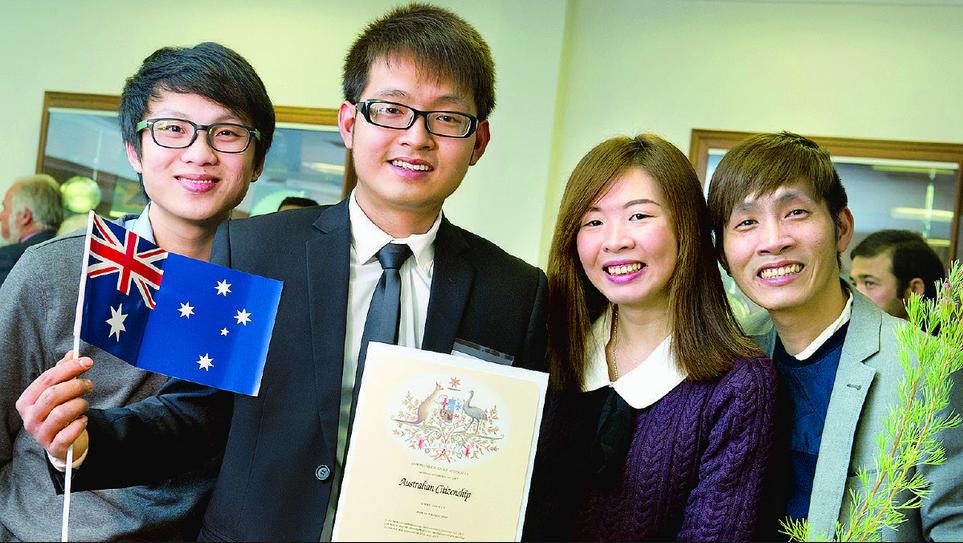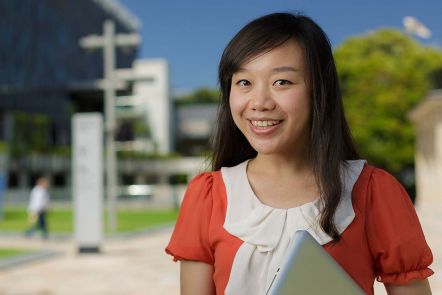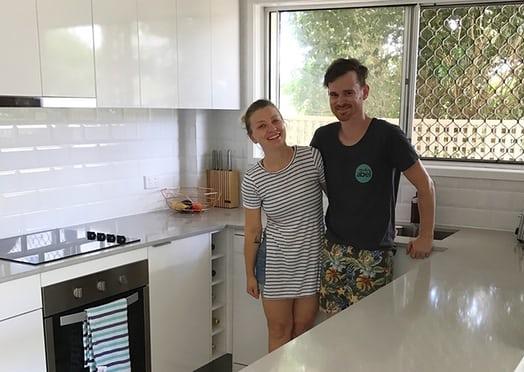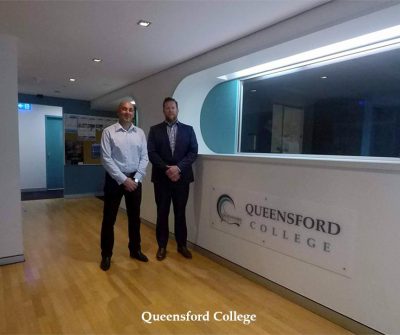Lazy mass immigration policy out of Canberra is destroying Australia’s urban quality of life and driving White Genocide.
Flogging education to foreigners as some perverted ‘export’ is just part of this mass immigration agenda. Of course on graduation they stay. These foreigners don’t go back home after they graduate. They qualify for one of those foreign graduate work visas and a pathway to permanent Australian residency and ultimately for a right to supplant Australians as ‘citizens’.
Canberra knows all about citizenship – half of the mongrels are foreign with foreign allegiances. Plibersek owns an investment property in Ljubljana in her native Slovenia.

“Of course that’s why we study in Australia. Now we bring all relatives out from China.”
Foreign Students Taking over Brisbane Rents
Property in the CBD of Brisbane will increasingly house education “providers” for overseas students, mainly Asian and usually from China. Good business for real estate agents, education providers and foreigners. Bad news for local business looking for easier rents. It is a disturbing trend of the ongoing alienation of Australia’s central cities from any sort of Australian interest.
Nationalists believe it is time to wind back and back and back overseas student programs. They are all back-doors to immigration and the cleansing of Australians from their own education facilities and from professional employment.
The foreign invasion of Sydney and Melbourne has moved on to plaguing Brisbane. Brisbane’s office leasing market has been steep amid increased requirements to cater for rising enrolments by foreign students. The PC leftard lingo euphemistically brands them ‘international students’, but we know what ether are why they’re here.
Backdoor Immigration aka ‘Temporary Graduate visa (subclass 485)‘

Education providers have been quietly taking office space in the city over the past three years, chalking up commitments with a total net absorption of more than 30,000sq metres since 2015.
Emerging as a strong sub-sector in the Brisbane office market, the trend has come off the back of an influx of foreign students due to the lower Australian dollar.
American global real estate agent and property developer Jones Lang Lasalle (JLL) senior analyst in strategic research, Tom Broderick, said from the beginning of 2015, the Australian dollar had weakened to a range of between 0.70 and 0.80 USD. “This has made studying in Australia much more affordable for foreign students compared with comparable destinations such as the United States,” he said.
“So far in 2017, foreign student enrolments in Queensland have increased by 13.2 per cent compared to the same time last year. A significant amount of this growth in student numbers has come from Asia, particularly China. However, students from Central and South American have also been a large contributor to the growth over the past year.”
 “Come on down to Brisvegas!”
“Come on down to Brisvegas!”
Mr Broderick said “The trend is having a positive effect on office leasing demand in Brisbane,” he said. “About two-thirds of this expansion has been located in the CBD market. About 70 per cent of the space taken by education providers was being occupied by vocational education and language schools while about 15 per cent was for universities.”
He also said the preference was towards secondary grade office space due to the affordability factor.
“Approximately 60 per cent of the space taken over the past three years has been in secondary grade buildings compared with 40 per cent in prime,” Mr Broderick said.
The expansion by education providers has been a trend across Australia, with Sydney, Melbourne and Brisbane “leading the way”. JLL’s latest research has recorded a slight increase in vacancy in the Brisbane CBD, rising to 15.8 per cent in this year’s third quarter compared with 15.5 per cent last quarter.
“The main reason for the increase was the State Government consolidating into existing space after expanding their office footprint significantly in 2016,” Mr Broderick said. “Vacancy in the Brisbane Near City market fell in Q3 to 17.1 per cent from 17.7 per cent, mainly due to withdrawals of office space for residential development.”
Aussies Priced Out of Brisbane
Meanwhile, for Ordinary Australians, mortgages now soak up 42% of average income in Sydney, 37% in Melbourne and 23% in Brisbane, with other capitals around 20%. The Sydney market is as unaffordable as any time in 26 years, and other capitals are also struggling.
After more than 20 years as a property analyst consulting to developers, Michael Matusik wonders why there aren’t any Occupy Wall Street-style protests from Australians looking to buy their first homes.
For those on the outside looking in, there’s a special level of pain in Sydney and Melbourne right now. But the problem of “eye-watering” prices stacked up against average incomes extends well beyond the biggest cities, Brisbane-based Matusik says.
“I’m surprised there isn’t a lot more, not rioting in the streets, but close to it,” he says.
Australia First would support Australians rioting in the streets.
“This idea of the Australian dream is goneski, unless you’ve got $1.2m to $1.6m..or your parents have got money and they can back you”
Prices have continued to rise this year in both Sydney and Melbourne. It’s a sad realisation: to get an affordable family home, you’re having to move an hour south of a major CBD.
David, a Sydney public servant who is 40 and single, finds himself priced out of buying in the inner-city neighbourhoods he’s lived in his whole life. That’s despite him earning roughly double the average Australian wage at $150,000 a year (David hasn’t forgotten the “disgraceful” comment by the former federal treasurer Joe Hockey that aspiring homeowners should “get a good job that pays good money”).
So David rents a bedsit in Miller’s Point for $500 a week.
“This idea of the Australian dream is goneski, unless you’ve got $1.2m to $1.6m in [central] Sydney, or your parents have got money and they can back you,” he says.
In Brisbane, schoolteacher Sara Beeston counts herself lucky. She bought her first home last year: a two-bedroom unit in inner-city Fortitude Valley, in a building with a pool and a gym. There is “no way” she could afford equivalent digs in Melbourne, where her sister, a lawyer, lasted only a year in her one-bedroom Carlton apartment before putting it up on Airbnb and renting further out. “She loves to be around people, and being in a unit by herself and the size it was, almost killed her,” Beeston says.
Holly Carson and Josh Abel bought an a two-bedroom inner suburban apartment in Brisbane and now pay less on their mortgage than they did in rent.

But even in Brisbane, “the long and the short of it” is that Beeston – now in her 30s – probably wouldn’t own a home without her father’s help gathering a deposit. She says she was mindful of a coming apartment glut in Brisbane helping her as a buyer, and she’ll be happy just getting her money back as a seller.
Holly Carson also thinks herself lucky. The hair salon owner, 33, also bought her first home in Brisbane last year with her partner, Josh Abel, 30, who runs his own industrial design business. Their two-bedroom unit in Annerley, 6km from the central business district, carries a mortgage they can service on one income, to allow for career transitions, overseas holidays “and smashed avo on toast”.
They saved hard for a 30% deposit over two years and now pay $230 a week on their mortgage, versus $385 a week when they rented.
And Ordinary Australians are being denied children because unaffordable housing means they can’t afford to. Some couples they know chose “trendier” areas with mortgages that swallow up half their income, leaving them in “scary territory” if one partner gets pregnant or loses a job. Carson wonders about the “sad trade-off” many people their age are forced to make when they have children.
“It’s a sad realisation: to get an affordable family home, you’re having to move an hour south of a major CBD and your limits are public transport and you’re kind of sacrificing your lifestyle.”
The BIS Oxford figures show Brisbane was Australia’s third least affordable capital for housing, at 23.4% of disposable income.
By another simpler but widely recognised measure – the median house price divided by median household income – every Australian capital and most regional centres rate as “seriously or severely unaffordable”.
Matusik has argued that, while it’s a different story when apartments are considered, capital city house prices must drop 37% on average to be truly “affordable”, given local wages, with Sydney (47%), Adelaide (29%) and Darwin (28%) required to fall the furthest.
“I have a daughter who lives in Hobart, and let me tell you, it’s tough in Hobart,” Matusik says. “We might think Hobart’s cheap but it’s not for people living where unemployment’s 12 to 15% and some people haven’t had a wage increase since God knows when.”
Richard Robinson, senior economist for BIS Oxford, says the affordability problem, most acute in Sydney and Melbourne, is mainly a story of “wealthy people investing in property and driving up price and demand”. These are “not investors but speculators”, says Steve Keen, an economist and academic who has long pointed to rising mortgage credit from banks as the fundamental driver of high property prices.
Robinson, Keen, Matusik and many others believe the federal government should banish the key incentives for making money simply by betting on the rising price of an existing house. Phasing out negative gearing to stop investors writing off rental losses on multiple properties against their income, and tax discounts on capital gains, Robinson says, are key to “deflating the bubble slowly before it goes pop”.
The RBA board has noted that, despite measures to reinforce more prudent investor lending, it was growth in loans to investors and not occupiers that rose in the last six months, and mostly in Sydney and Melbourne where house values have soared. Growth in overall housing credit “continued to outpace growth in household incomes, suggesting that the risks associated with the housing market and household balance sheets had been rising”, it said.
Brisbane is following Melbourne and Sydney.
Low income earners, students and pensioners are being locked out of Brisbane’s rental market. The National Shelter and SGS Economics containing the Rental Affordability Index reveals most postcodes in inner to middle Brisbane have remained moderately unaffordable to unaffordable. Single pensioner households are spending up to 67 per cent of their income on rent while students were forking out up to 60 per cent of their income on rent.
Ian Yates, chief executive of seniors advocacy body COTA Australia, said National Shelter’s latest Rental Affordability Index was a stark reminder of just how dire the housing situation was for too many Australians.
“Too often we hear stories of age pensioners who are left to choose between using the last of their income to buy food or medication once they have met their obligations for rent and utilities,” he said.
The Rental Vulnerability Index deems median rents higher than 30 per cent of a household’s income to be unaffordable. It reveals how exposed tenants are to problems that may make their rental housing unaffordable, insecure or inappropriate.
The average rental household in Greater Brisbane spends 25 per cent of their total income on rent. The RVI showed in south-east Queensland parts of Chandler, Inala, Durack, Logan and Riverview ranked at the top end of the scale while renters in most of inner Brisbane, Wakerley, Gumdale, Nathan and Ferny Grove faced relatively low to no levels of rental vulnerability.
Many vulnerable households have been pushed out to the urban fringe and regional areas in search of cheaper housing and were still facing rental stress, with fewer opportunities to improve their circumstances over the long-term.
According to the Department of Immigration and Border Protection, there are about 72,000 foreign students currently enrolled in Queensland and a big chunk of that population is based in Brisbane. The numbers are even expected to grow in the next few years as the government and top educational institutions are making an effort to make education and accommodation significantly accommodating.
Labor like Liberal Brisbane Lord Mayor Graham Quirk has a Brisbane’s 2022 New World Action Plan for massive over-development of Brisbane to make the city a massive growth centre for foreigners – trade, tourism, education. Brisbane is promoted as a multicultural diverse city because Ordinary Australians are being pushed out to make way for yellow skins. It’s a “final solution” for White Australians in Brisbane.
That’s why 300,000 White Australians have existed Brisbane for the Sunshine Coast and another 100,000 to the Fraser Coast – these regions are still Aussie. Many young Brisbanians have even left for Victoria. Queensland; beautiful once, polluted by foreigners next.
Foreign Student Colleges
Queensford College in Brisbane exists for foreign students.

It’s website boasts:
“Queensford College is here to help. Queensford College is a nationally recognised registered training organisation (RTO) and is an emerging choice of students abroad in helping them succeed academically and professionally. It is a gateway to what quality education in Brisbane can offer. International students will definitely feel at home in Brisbane, as there are a lot of migrants who live and study here. The welcoming and friendly attitude of locals make it very easy to adapt and adjust to newcomers. In fact, according to the Brisbane City Council Community Profiles, about a quarter of Brisbane’s population are of those who were born outside Australia and more than 17% of households speak languages other than English.”
QUT (Queensland University of Technology) also based in Brisbane, states “we have a global outlook, including almost 8,000 international students from more than 100 countries.”
The University of Queensland boasts 13,300 foreign students. How many of them go back to where they came from? How many graduate and immediately apply for visa 485?
There are ominous signs of the recolonisation of Australia everywhere.
The Aborigines have been on to this since 1788. Australia is being recolonised by migrants of all sorts and by China. So when a petty thing like a a mural proclaiming Australia as “always” Aboriginal land is due to be painted over by a developmentalist Sydney council – why would we be surprised?
Maybe the Greens or the Trotskyites might write us a paper: ‘Aboriginal Land Rights In An Asian Australia’ – or some such similar. Why not ‘Aborigines In A Country Of 100 Million’?
Ned Kelly’s Mongolian Warning
Ned Kelly was also on to this in his admonishing letter to the Premier of New South Wales on March 14, 1879:
“My dear Sir Henry Parkes
I find by the newspapers that you have been very liberal in offering a reward for the Kelly gang or any one of them Now Sir Henry the man that takes I Captain E. Kelly will have to be a plucky man for I do not intend to be taken alive. And as I would as soon die in NSW as Victoria I will give you or any other person who wishes to take me a fair chance to try your pluck. I am at present not very far from Bathurst (in fact I have been in the town of Bathurst and has taken a peep at the bank) Now I tell you candidly that I intend to rob Bathurst and particularly the bank. So now you are warned of course I will not say what time I and the gentlemen that follows in my train will visit the City of the plains. But one thing you can count on that I will pay it a visit. Now Sir Henry I tell you that highway robbery is only in its infancy for the white population is been driven out of the labour market by an inundation of mongolians and when the white man is driven to desperation there will be desperate times. I present my respects to the Sydney police
yours E. Kelly.”
